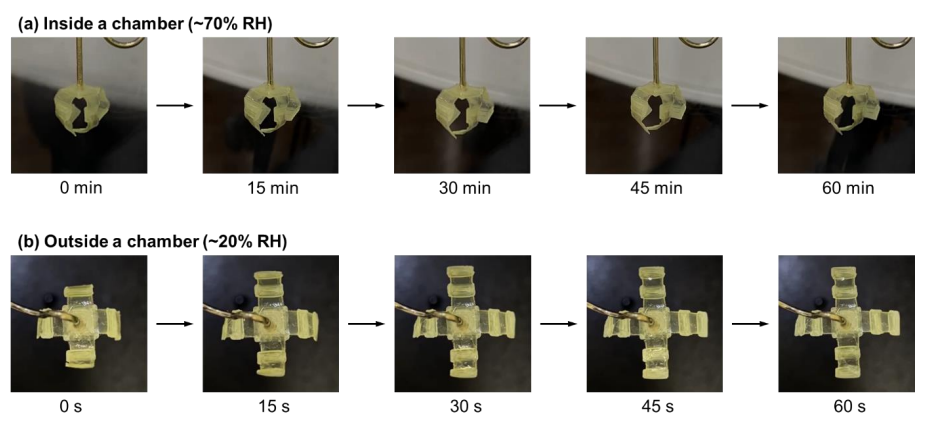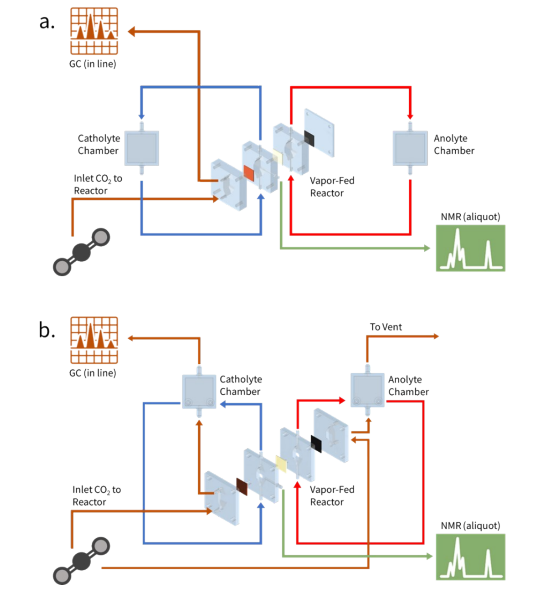We’re starting off with some heavy-duty research in today’s 3D Printing News Briefs as scientists from Pusan National University are 4D printing humidity-responsive polymers and 3D printed components are helping to improve the performance of an electrochemical reactor. Astronomers are 3D printing handheld stellar nurseries, and we don’t mean the kind where your baby goes to sleep. Hybrid AM technology is being used to fabricate carbon fiber-filled molds for an automotive project, and finally, a 21-meter-long 3D printed bridge was unveiled in China.
4D Printing Humidity-Responsive Polymers

Comparison of shape fixing capability when the humidifying source was removed (a) inside a humidity chamber (~70% RH) and (b) outside a humidity chamber (~20% RH).
Innovations like sensors, smart textiles, soft robots, and weather-responsive architecture are typically based on materials that respond to external stimuli, such as light, temperature, and humidity, by changing shape. Liquid crystal (LC)-based lightly crosslinked polymers, or LC elastomers (LCEs), have this actuating ability, but most don’t respond to humidity changes, or if they do, they’re brittle. A team of scientists from Pusan National University in Korea, have developed a new class of smart LCEs, which can be 3D printed, are very deformable, and respond to environmental humidity—making them 4D printed. First, they prepared LC ink using dimethylamino group functionalized LC oligomers, which were then 3D printed, using UV-assisted direct-ink-writing technology, in a variety of geometries. Finally, an acidic solution was used to activate the 3D printed LCE surfaces, and the resulting novel humidity-responsive LCEs can undergo both programmed and reversible shape changes, such as twisting, bending, and forming the letters ‘P,’ ‘N,’ and ‘U.’
“Our LCE leads the way in designing humidity-responsive complex structures that can be applied to 4D printing technology. This can be one of the key materials technologies that innovates our futures for the industrial revolution, Industry 4.0,” explained Professor Suk-kyun Ahn, who led the team.
“The day is not far when we may see smart textiles or shoes that can spontaneously change their breathability in response to weather conditions, or soft actuators that can operate driven by moisture, without an electric motor.”
You can learn more by reading the Pusan team’s published study.
3D Printing Improves Performance of Electrochemical Reactor

Simplified system design for electrochemical CO2 reduction experiments. (a) System design for Generations 1 & 2. (b) System design for Generation 3 experiments. Blue arrows indicate the catholyte flow direction, red arrows indicate the anolyte flow direction, and orange arrows indicate the gas flow direction. Gas chromatography (GC) samples are measured in real-time with the experiment. Electrolyte samples for NMR were recovered at the conclusion of each experiment.
Researchers from Lawrence Livermore National Laboratory, collaborating with Stanford University and oil and gas company Total American Services, recently used 3D printing to rapidly enhance the performance of electrochemical reactors used for converting CO2 into chemicals, material feedstocks, and energy sources. The collaborating researchers are working under a cooperative research and development agreement (CRADA), and published a paper proving the 3D printed components allowed the vapor-fed electrochemical systems to produce higher yields of feedstocks and fuels, like ethanol and ethylene, and majorly speed up the process of building the reactors. The team used projection micro-stereolithography and other photochemical-based 3D printing processes at LLNL to design and print new housings for the reactors, in an effort to find better ways to control the environment around the catalyst. By using the technology to optimize the design, they were able to improve the overall mass transport for delivering reactants to, and removing products from, the catalyst surroundings, as well as introduce what the researchers call a “paradigm-shifting approach to designing future reactors and rethinking how chemical reactions are done.”
“The things going on in the vicinity of the catalyst and their effect on the overall reactions are understudied, so we decided that would be our niche. The community had never leveraged the power of 3D printing to accelerate this design-build-test-cycle. Our team made some really rapid discoveries working with somewhat ordinary and unexciting catalysts that people have used for a long time, and through this understanding and control of the local environment, we’ve been able to achieve record-breaking or near record properties and performance,” explained co-principal investigator Eric Duoss, a research engineer who leads LLNL’s Center or Engineered Materials and Manufacturing.
“We’ve shown this first demonstration of what can be done with CO2 reactors, but the potential impact is much larger than that. This approach will accelerate scientific discovery and technology deployment to hopefully bridge the ‘valley of death’ and see these technologies commercialized at some point. Our climate and carbon challenges are immense, and they require these kinds of creative and disruptive solutions because we simply don’t have the time to wait.”
3D Printed Handheld Stellar Nurseries

These 3D printed stellar nursery models show regions of star formation. Image courtesy of Saurabh Mhatre.
Artist and astrophysicist Nia Imara, a professor of astronomy at the University of California Santa Cruz, has combined both of her passions to help scientists better visualize the giant clouds of gas and dust that birth stars, also known as a stellar nursery. She and her team used high-resolution, bitmap-based 3D printing to fabricate polished orbs—small enough to fit in your hand—that resemble giant marbles containing beautiful swirling patterns. These 3D printed stellar nursery models feature patterns that come from simulations that were run of star-forming clouds, showing how the nurseries are affected by different processes, such as magnetic fields and turbulence. Opaque resin was used to print the models, and Amara’s team also printed half-spheres to offer a simulated view into the cross sections of the stellar nurseries.
In a statement from UC Santa Cruz, Imara explained, “We wanted an interactive object to help us visualize those structures where stars form so we can better understand the physical processes.
“If you have something winding around through space, you might not realize that two regions are connected by the same structure, so having an interactive object you can rotate in your hand allows us to detect these continuities more easily.”
Imara plans to use the 3D printed models in an astrophysics course she will be teaching this fall. To learn more, you can read the published paper here.
Hybrid Manufacturing Helps with Custom Vehicle Restoration

A carbon fiber composite model (black) shown beside a carbon fiber-filled polyamide mold (green) 3D printed using CMS’ new hybrid 3D printing/milling machine.
In June, multi-axis machining specialist CMS SpA, based in Italy and the US, introduced its hybrid composite large-format Kreator 3D printer and multi-axis milling machine, and has now announced the first commercial project developed with the technology. Together with Italian company Bercella S.r.l., which specializes in large and complex structures, CMS is using the new hybrid Kreator to fabricate carbon fiber-filled molds for Bercella’s custom Restomod Maserati vehicle restoration project. CMS worked with Fraunhofer IWU to develop the Kreator, which combines milling with large-format additive manufacturing (LFAM), and the first use case was the redesign of 26 body components, including the bumpers, door, roof, and hood, for the Restomod Maserati MV 3200 GTC. Using the CMS Kreator, the components were built from carbon fiber prepreg, manufactured via hand layup on molds—3D printed out of 40% carbon fiber-filled PA6—and then cured in an autoclave. The ultimate goal is to produce an entire carbon fiber restoration vehicle out of 3D printed molds.
“We are particularly proud to be part of this extraordinary project. Sustainability and production flexibility are the keywords that we shared with Franco Bercella years ago while talking about the enormous opportunities that a particular additive manufacturing solution for large formats could have brought to the composite materials sector,” said Giovanni Negri, CEO of CMS SpA. “The Restomod project begins to make us touch these opportunities firsthand.”
3D Printed Bridge Unveiled in Chengdu
Finally, a park in Chengdu, China is now home to a 3D printed bridge that’s over 21 meters long. The bridge, 3D printed out of polymer composite materials instead of concrete or metal, is actually part of the larger Liuyun Bridge in the city’s Yimahe Park. This bridge measures 66.8 meters long, and the flexible 21.58-meter-long 3D printed portion is 8 meters at its widest point and 2.68 meters at its highest point. Made from 12 tonnes of polymer ASA and glass fiber for more strength and weather resistance, the design team of China Southwest Architecture cooperated with a printing team in Shanghai, and used the country’s largest polymer printer to build the bridge, which was inspired by the “free running form of the Stage Horse River and the dancing silk.” The fully automated printing system took 35 days to complete the 3D printed portion of the Liuyun Bridge.
Cheng Rui, head of China Southwest Architecture, said, “The combination of industrial-scale 3D printing with a landscape bridge demonstrates the feasibility of ultra-large 3D printing technology for future applications in both architectural landscape and industrial fields.”
Subscribe to Our Email Newsletter
Stay up-to-date on all the latest news from the 3D printing industry and receive information and offers from third party vendors.
You May Also Like
US Army Corps of Engineers Taps Lincoln Electric & Eaton for Largest 3D Printed US Civil Works Part
The Soo Locks sit on the US-Canadian border, enabling maritime travel between Lake Superior and Lake Huron, from which ships can reach the rest of the Great Lakes. Crafts carrying...
Construction 3D Printing CEO Reflects on Being Female in Construction
Natalie Wadley, CEO of ChangeMaker3D, could hear the words of her daughter sitting next to her resounding in her head. “Mum, MUM, you’ve won!” Wadley had just won the prestigious...
Blue Laser-powered M600 3D Printer Launched by Meltio
Founded in 2019 as a joint venture between Additec and Sicnova, metal 3D printer OEM Meltio develops and manufactures high-performance and easy-to-use metal 3D printing solutions that use its patented wire-laser metal...
3D Printed Storage Tanks Cut Material Costs by 25%
In a previous article, “Concrete Dreams: Let’s Print Money, Not Houses,” we discussed how the spotlight on 3D printing homes might be misplaced. Bollards, pedestrian bridges, and concrete tanks could...






























